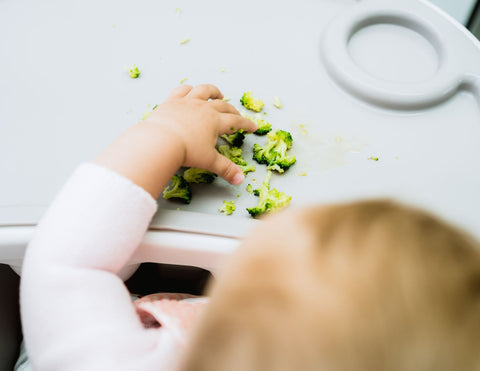When it comes to introducing solids to your baby, there are many different approaches to choose from. One approach that has gained popularity in recent years is baby-led weaning. But what exactly is baby-led weaning, and is it the right choice for you and your little one?
Baby-led weaning, or BLW for short, is a method of introducing solids that involves letting your baby feed themselves from the very beginning. Instead of spoon-feeding purees, you offer your baby a variety of finger foods that they can pick up, explore, and eat on their own.

Proponents of BLW argue that it allows babies to learn to eat at their own pace, promotes healthy eating habits, and encourages independence and self-regulation. Plus, it's a lot of fun to watch your little one explore new foods and textures!
But like any parenting decision, there are also some potential drawbacks to consider. For one, BLW can be messy. Like, really messy. Your baby is going to be exploring their food with their hands, their face, and maybe even their feet. Be prepared to do a lot of cleaning up after meals.
There's also the question of safety. While BLW is generally considered safe, it's important to make sure that the foods you offer are age-appropriate and cut into small, manageable pieces. You'll also want to keep an eye on your baby to make sure they're not choking or gagging.
Here are some tips for getting started with baby-led weaning:
-
Start with soft, easy-to-grasp foods like ripe banana, avocado, or steamed sweet potato.
-
Offer a variety of foods and textures to help your baby develop their palate and motor skills.
-
Be patient and let your baby explore at their own pace. It may take a few tries before they actually swallow anything!
-
Make sure your baby is seated upright and supervised at all times.
-
Have a camera ready to capture those adorable messy moments!
- Don't forget to let them wash it down with some milk warmed with your Baby's Brew portable bottle warmer!

So, should you try baby-led weaning? Ultimately, it depends on your family's preferences and your baby's individual needs. Some babies take to BLW like a duck to water, while others may need more time to get the hang of it.
One thing's for sure: if you do decide to give baby-led weaning a try, you're in for a wild ride. There's nothing quite like watching your baby discover the joy of food for the first time, and the messes they make along the way are just part of the fun.
In conclusion, baby-led weaning can be a messy, fun, and empowering way to introduce solids to your baby. As with any parenting decision, it's important to weigh the pros and cons and make the choice that's best for your family. But if you do decide to give BLW a try, get ready for some seriously adorable photo ops!
FAQ:
Is baby-led weaning safe?
Baby-led weaning is generally considered safe when proper precautions are taken. It's important to offer age-appropriate foods and cut them into small, manageable pieces. Always supervise your baby during meals and be aware of potential choking hazards. By following these guidelines, you can ensure a safe and enjoyable experience for your little one.
How do I know if my baby is ready for baby-led weaning?
Babies are typically ready for baby-led weaning around six months of age when they can sit up with minimal support and have developed the ability to bring objects to their mouth. They should also have lost the tongue-thrust reflex, which automatically pushes objects out of their mouth. If your baby is showing these signs of readiness, it may be time to give baby-led weaning a try.
What are the benefits of baby-led weaning compared to traditional spoon-feeding?
Baby-led weaning offers several benefits. It allows babies to explore different textures and flavors, promoting a varied and healthy diet. It also helps develop their motor skills as they learn to grasp and manipulate foods. Baby-led weaning encourages self-regulation, as babies learn to eat until they're satisfied rather than being spoon-fed a predetermined amount. Additionally, it can be a fun and interactive experience for both baby and parents.
What are some appropriate first foods for baby-led weaning?
When starting baby-led weaning, it's best to offer soft, easy-to-grasp foods. Some suitable options include ripe bananas, cooked sweet potatoes, soft avocado slices, steamed carrots or broccoli, and strips of well-cooked chicken or fish. Remember to cut the food into finger-sized pieces to ensure your baby can handle them safely.
How can I prevent choking while practicing baby-led weaning?
Choking can be a concern during baby-led weaning, but there are steps you can take to reduce the risk. Offer foods that are appropriate for your baby's age and developmental stage, and ensure they are cut into small, manageable pieces. Always supervise your baby closely during meals and be prepared to intervene if necessary. Familiarize yourself with the signs of choking and consider taking a CPR and first aid course to feel more confident in handling any potential emergencies.


